Xintong Li
A Survey on Personalized and Pluralistic Preference Alignment in Large Language Models
Apr 09, 2025Abstract:Personalized preference alignment for large language models (LLMs), the process of tailoring LLMs to individual users' preferences, is an emerging research direction spanning the area of NLP and personalization. In this survey, we present an analysis of works on personalized alignment and modeling for LLMs. We introduce a taxonomy of preference alignment techniques, including training time, inference time, and additionally, user-modeling based methods. We provide analysis and discussion on the strengths and limitations of each group of techniques and then cover evaluation, benchmarks, as well as open problems in the field.
ASRL:A robust loss function with potential for development
Apr 09, 2025Abstract:In this article, we proposed a partition:wise robust loss function based on the previous robust loss function. The characteristics of this loss function are that it achieves high robustness and a wide range of applicability through partition-wise design and adaptive parameter adjustment. Finally, the advantages and development potential of this loss function were verified by applying this loss function to the regression question and using five different datasets (with different dimensions, different sample numbers, and different fields) to compare with the other loss functions. The results of multiple experiments have proven the advantages of our loss function .
Toward Multi-Session Personalized Conversation: A Large-Scale Dataset and Hierarchical Tree Framework for Implicit Reasoning
Mar 10, 2025Abstract:There has been a surge in the use of large language models (LLM) conversational agents to generate responses based on long-term history from multiple sessions. However, existing long-term open-domain dialogue datasets lack complex, real-world personalization and fail to capture implicit reasoning-where relevant information is embedded in subtle, syntactic, or semantically distant connections rather than explicit statements. In such cases, traditional retrieval methods fail to capture relevant context, and long-context modeling also becomes inefficient due to numerous complicated persona-related details. To address this gap, we introduce ImplexConv, a large-scale long-term dataset with 2,500 examples, each containing approximately 100 conversation sessions, designed to study implicit reasoning in personalized dialogues. Additionally, we propose TaciTree, a novel hierarchical tree framework that structures conversation history into multiple levels of summarization. Instead of brute-force searching all data, TaciTree enables an efficient, level-based retrieval process where models refine their search by progressively selecting relevant details. Our experiments demonstrate that TaciTree significantly improves the ability of LLMs to reason over long-term conversations with implicit contextual dependencies.
Active Learning for Direct Preference Optimization
Mar 03, 2025Abstract:Direct preference optimization (DPO) is a form of reinforcement learning from human feedback (RLHF) where the policy is learned directly from preferential feedback. Although many models of human preferences exist, the critical task of selecting the most informative feedback for training them is under-explored. We propose an active learning framework for DPO, which can be applied to collect human feedback online or to choose the most informative subset of already collected feedback offline. We propose efficient algorithms for both settings. The key idea is to linearize the DPO objective at the last layer of the neural network representation of the optimized policy and then compute the D-optimal design to collect preferential feedback. We prove that the errors in our DPO logit estimates diminish with more feedback. We show the effectiveness of our algorithms empirically in the setting that matches our theory and also on large language models.
From Selection to Generation: A Survey of LLM-based Active Learning
Feb 17, 2025Abstract:Active Learning (AL) has been a powerful paradigm for improving model efficiency and performance by selecting the most informative data points for labeling and training. In recent active learning frameworks, Large Language Models (LLMs) have been employed not only for selection but also for generating entirely new data instances and providing more cost-effective annotations. Motivated by the increasing importance of high-quality data and efficient model training in the era of LLMs, we present a comprehensive survey on LLM-based Active Learning. We introduce an intuitive taxonomy that categorizes these techniques and discuss the transformative roles LLMs can play in the active learning loop. We further examine the impact of AL on LLM learning paradigms and its applications across various domains. Finally, we identify open challenges and propose future research directions. This survey aims to serve as an up-to-date resource for researchers and practitioners seeking to gain an intuitive understanding of LLM-based AL techniques and deploy them to new applications.
Mitigating Visual Knowledge Forgetting in MLLM Instruction-tuning via Modality-decoupled Gradient Descent
Feb 17, 2025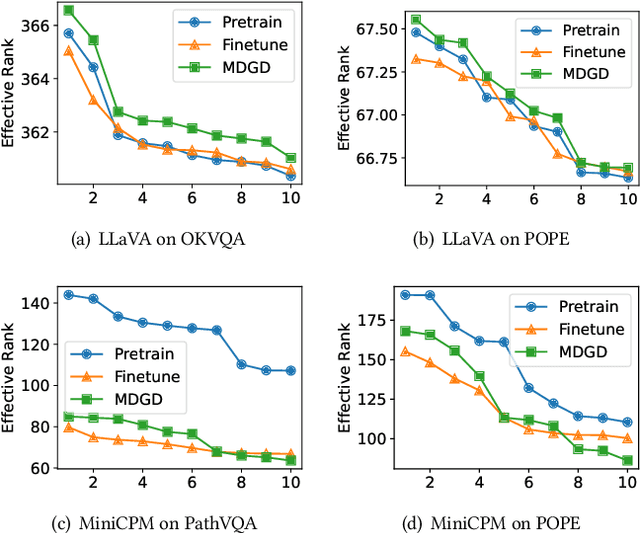
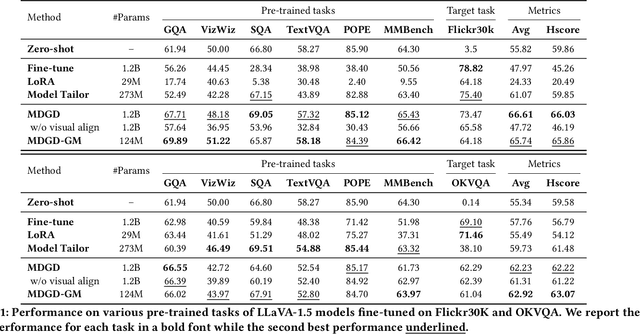

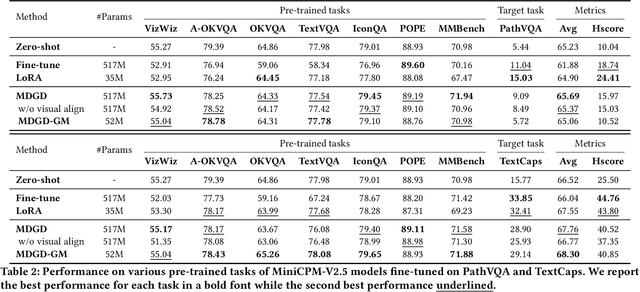
Abstract:Recent MLLMs have shown emerging visual understanding and reasoning abilities after being pre-trained on large-scale multimodal datasets. Unlike pre-training, where MLLMs receive rich visual-text alignment, instruction-tuning is often text-driven with weaker visual supervision, leading to the degradation of pre-trained visual understanding and causing visual forgetting. Existing approaches, such as direct fine-tuning and continual learning methods, fail to explicitly address this issue, often compressing visual representations and prioritizing task alignment over visual retention, which further worsens visual forgetting. To overcome this limitation, we introduce a novel perspective leveraging effective rank to quantify the degradation of visual representation richness, interpreting this degradation through the information bottleneck principle as excessive compression that leads to the degradation of crucial pre-trained visual knowledge. Building on this view, we propose a modality-decoupled gradient descent (MDGD) method that regulates gradient updates to maintain the effective rank of visual representations while mitigating the over-compression effects described by the information bottleneck. By explicitly disentangling the optimization of visual understanding from task-specific alignment, MDGD preserves pre-trained visual knowledge while enabling efficient task adaptation. To enable lightweight instruction-tuning, we further develop a memory-efficient fine-tuning approach using gradient masking, which selectively updates a subset of model parameters to enable parameter-efficient fine-tuning (PEFT), reducing computational overhead while preserving rich visual representations. Extensive experiments across various downstream tasks and backbone MLLMs demonstrate that MDGD effectively mitigates visual forgetting from pre-trained tasks while enabling strong adaptation to new tasks.
FAP-CD: Fairness-Driven Age-Friendly Community Planning via Conditional Diffusion Generation
Dec 21, 2024Abstract:As global populations age rapidly, incorporating age-specific considerations into urban planning has become essential to addressing the urgent demand for age-friendly built environments and ensuring sustainable urban development. However, current practices often overlook these considerations, resulting in inadequate and unevenly distributed elderly services in cities. There is a pressing need for equitable and optimized urban renewal strategies to support effective age-friendly planning. To address this challenge, we propose a novel framework, Fairness-driven Age-friendly community Planning via Conditional Diffusion generation (FAP-CD). FAP-CD leverages a conditioned graph denoising diffusion probabilistic model to learn the joint probability distribution of aging facilities and their spatial relationships at a fine-grained regional level. Our framework generates optimized facility distributions by iteratively refining noisy graphs, conditioned on the needs of the elderly during the diffusion process. Key innovations include a demand-fairness pre-training module that integrates community demand features and facility characteristics using an attention mechanism and min-max optimization, ensuring equitable service distribution across regions. Additionally, a discrete graph structure captures walkable accessibility within regional road networks, guiding model sampling. To enhance information integration, we design a graph denoising network with an attribute augmentation module and a hybrid graph message aggregation module, combining local and global node and edge information. Empirical results across multiple metrics demonstrate the effectiveness of FAP-CD in balancing age-friendly needs with regional equity, achieving an average improvement of 41% over competitive baseline models.
GUI Agents: A Survey
Dec 18, 2024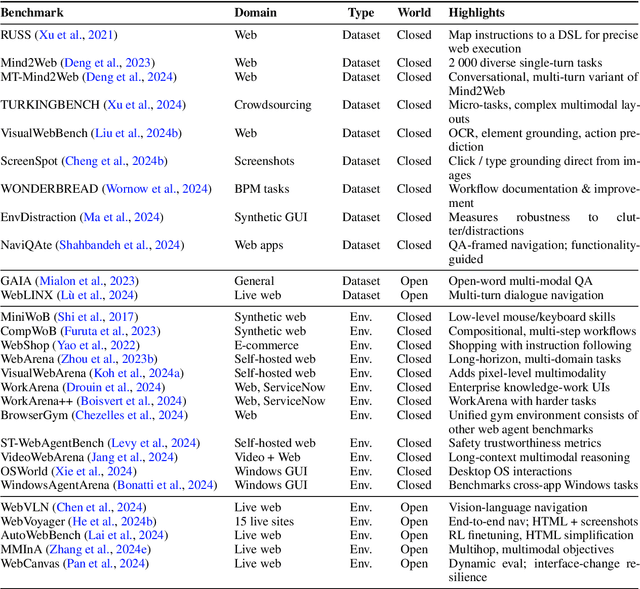
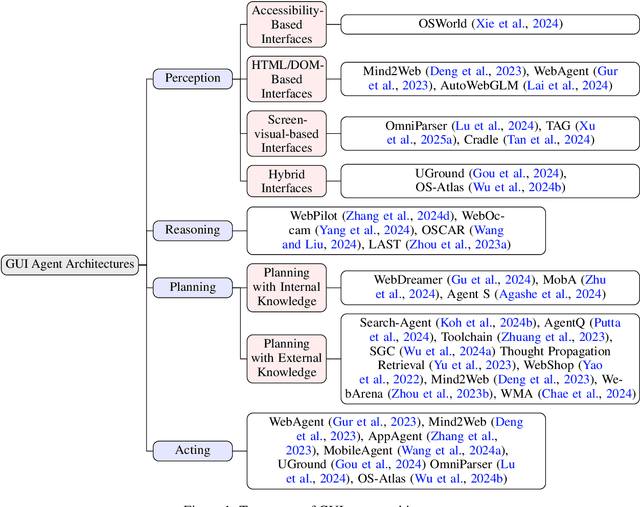

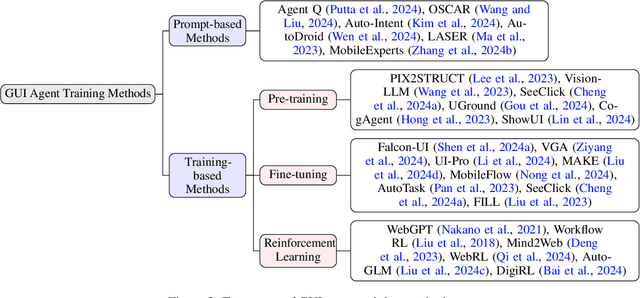
Abstract:Graphical User Interface (GUI) agents, powered by Large Foundation Models, have emerged as a transformative approach to automating human-computer interaction. These agents autonomously interact with digital systems or software applications via GUIs, emulating human actions such as clicking, typing, and navigating visual elements across diverse platforms. Motivated by the growing interest and fundamental importance of GUI agents, we provide a comprehensive survey that categorizes their benchmarks, evaluation metrics, architectures, and training methods. We propose a unified framework that delineates their perception, reasoning, planning, and acting capabilities. Furthermore, we identify important open challenges and discuss key future directions. Finally, this work serves as a basis for practitioners and researchers to gain an intuitive understanding of current progress, techniques, benchmarks, and critical open problems that remain to be addressed.
OCEAN: Offline Chain-of-thought Evaluation and Alignment in Large Language Models
Oct 31, 2024
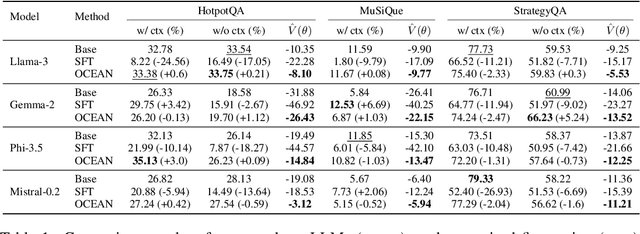
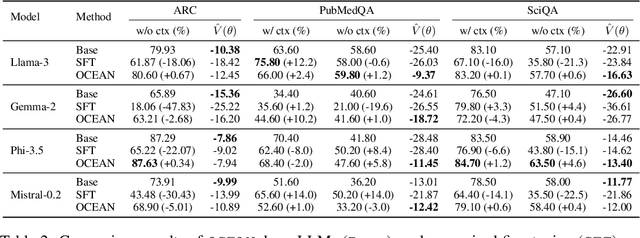

Abstract:Offline evaluation of LLMs is crucial in understanding their capacities, though current methods remain underexplored in existing research. In this work, we focus on the offline evaluation of the chain-of-thought capabilities and show how to optimize LLMs based on the proposed evaluation method. To enable offline feedback with rich knowledge and reasoning paths, we use knowledge graphs (e.g., Wikidata5m) to provide feedback on the generated chain of thoughts. Due to the heterogeneity between LLM reasoning and KG structures, direct interaction and feedback from KGs on LLM behavior are challenging, as they require accurate entity linking and grounding of LLM-generated chains of thought in the KG. To address the above challenge, we propose an offline chain-of-thought evaluation framework, OCEAN, which models chain-of-thought reasoning in LLMs as an MDP and evaluate the policy's alignment with KG preference modeling. To overcome the reasoning heterogeneity and grounding problems, we leverage on-policy KG exploration and RL to model a KG policy that generates token-level likelihood distributions for LLM-generated chain-of-thought reasoning paths, simulating KG reasoning preference. Then we incorporate the knowledge-graph feedback on the validity and alignment of the generated reasoning paths into inverse propensity scores and propose KG-IPS estimator. Theoretically, we prove the unbiasedness of the proposed KG-IPS estimator and provide a lower bound on its variance. With the off-policy evaluated value function, we can directly enable off-policy optimization to further enhance chain-of-thought alignment. Our empirical study shows that OCEAN can be efficiently optimized for generating chain-of-thought reasoning paths with higher estimated values without affecting LLMs' general abilities in downstream tasks or their internal knowledge.
CoMMIT: Coordinated Instruction Tuning for Multimodal Large Language Models
Jul 29, 2024



Abstract:Instruction tuning in multimodal large language models (MLLMs) aims to smoothly integrate a backbone LLM with a pre-trained feature encoder for downstream tasks. The major challenge is how to efficiently find the synergy through cooperative learning where LLMs adapt their reasoning abilities in downstream tasks while feature encoders adjust their encoding to provide more relevant modal information. In this paper, we analyze the MLLM instruction tuning from both theoretical and empirical perspectives, where we find unbalanced learning between the two components, i.e., the feature encoder and the LLM, can cause diminishing learning gradients that slow the model convergence and often lead to sub-optimal results due to insufficient learning. Inspired by our findings, we propose a measurement to quantitatively evaluate the learning balance, based on which we further design a dynamic learning scheduler that better coordinates the learning. In addition, we introduce an auxiliary loss regularization method to promote updating of the generation distribution of MLLMs considering the learning state of each model component, which potentially prevents each component from gradient diminishing and enables a more accurate estimation of the learning balance coefficient. We conduct experiments with multiple LLM backbones and feature encoders, where our techniques are model-agnostic and can be generically integrated with various MLLM backbones. Experiment results on multiple downstream tasks and modalities in vision and audio, demonstrate the proposed method's better efficiency and effectiveness in MLLM instruction tuning.
 Add to Chrome
Add to Chrome Add to Firefox
Add to Firefox Add to Edge
Add to Edge